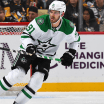Goaltenders who have been around long enough are aware the information includes knowing the preferred curve on many players' blades. So by the time the puck leaves the stick, NHL goalies already know where it is going.
"Without reading those signals, you don't have a chance," Vancouver Canucks veteran Ryan Miller said. "Most people think we are completely reacting to the puck, but if you are not reading, you are beat. On most shots from a Grade A scoring opportunity, it's almost physically impossible to catch up to the puck unless you are anticipating. If you miss the release point of a shot, even though you might catch up to seeing the puck, you are already behind."
That anticipation requires being able to see the puck, which is why there will be players talking about "taking the eyes" away from a hot goalie during the Stanley Cup Playoffs. But it's not only about not letting that goaltender see the puck all the way to the net. Preventing him from seeing the release, not allowing the goalie to gather all those clues about where the puck is headed, is often enough.
"I'm a real big shot-reader," Tampa Bay Lightning starter Ben Bishop said. "You'll see me sometimes stand on my feet making saves. It's one of those things you learn, you know guys in the League, their releases and where they like to go. If you can't see it, you have to kind of go down first and react second, and then you are usually a little late."
Teams have gotten better at creating those delays, using moving and stacked screens to force goaltenders into more of those blocking, down-first situations.



















